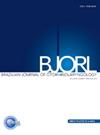耳硬化手术的功能结局
IF 1.7
4区 医学
Q2 OTORHINOLARYNGOLOGY
引用次数: 0
摘要
目的评价耳硬化手术的效果,并研究其功能成功的预测因素。方法回顾性分析2000年1月至2020年12月在耳鼻喉科和头颈外科手术的322例患者,相当于418只耳朵。结果以术后残余气骨间隙(PRABG)≤10 dB为标准,89.5%的患者剪骨成功;94.3%的患者符合传导增益≥20db标准;96.4%的患者根据耳蜗储备标准进行改善;88.8%的患者符合空气骨间隙改善(ABGi)≥70%标准,81.8%的患者符合所有标准。术后短、中、长期调性听力学可叠加,反映听力结果的稳定性。据报道,79.2%的病例耳鸣消退。听力成功的独立预测因子为Aubry的听力测量I期和II期,平均术前空气曲线40 dB和铂切开术。耳鸣消退的独立预测因子为男性、无噪声暴露和威隆放射学I期和II期。结论确定影响手术功能结果的因素,可以更好地选择干预对象,为患者提供更多相关信息。证据水平:三级:非随机对照队列或随访研究。本文章由计算机程序翻译,如有差异,请以英文原文为准。
Functional outcomes of otosclerosis surgery
Objectives
The objectives of this work were to evaluate the results of otosclerosis surgery and to study the predictors of its functional success.
Methods
Our study was retrospective on 322 patients, equivalent to 418 ears operated in the otolaryngology and head and neck surgery department, from January 2000 to December 2020.
Results
Hearing success was noted in 89.5% of patients considering the Postoperative Residual Air Bone Gap (PRABG) ≤10 dB criterion; in 94.3% of patients according to the conductive gain ≥20 dB criterion; in 96.4% of patients based on the improvement of cochlear reserve criterion; in 88.8% according to the Air Bone Gap improvement (ABGi) ≥70% criterion and in 81.8% considering all these criteria. The short, medium and long-term postoperative tonal audiometries could be superimposed, reflecting the stability of the hearing results. A regression of tinnitus has been reported in 79.2% of cases. The independent predictors of hearing success were the Aubry's audiometric stages I and II, mean preoperative air curve >40 dB and platinotomy. The independent predictors of tinnitus regression retained were male sex, no exposure to loud noise and Veillon radiological stages I and II.
Conclusion
The identification of factors influencing the functional results of surgery allows a better selection of candidates for the intervention and more relevant information for patients.
Level of evidence
Level 3: Non-randomized controlled cohort or follow-up study.
求助全文
通过发布文献求助,成功后即可免费获取论文全文。
去求助
来源期刊

Brazilian Journal of Otorhinolaryngology
OTORHINOLARYNGOLOGY-
CiteScore
3.00
自引率
0.00%
发文量
205
审稿时长
4-8 weeks
期刊介绍:
Brazilian Journal of Otorhinolaryngology publishes original contributions in otolaryngology and the associated areas (cranio-maxillo-facial surgery and phoniatrics). The aim of this journal is the national and international divulgation of the scientific production interesting to the otolaryngology, as well as the discussion, in editorials, of subjects of scientific, academic and professional relevance.
The Brazilian Journal of Otorhinolaryngology is born from the Revista Brasileira de Otorrinolaringologia, of which it is the English version, created and indexed by MEDLINE in 2005. It is the official scientific publication of the Brazilian Association of Otolaryngology and Cervicofacial Surgery. Its abbreviated title is Braz J Otorhinolaryngol., which should be used in bibliographies, footnotes and bibliographical references and strips.
 求助内容:
求助内容: 应助结果提醒方式:
应助结果提醒方式:


